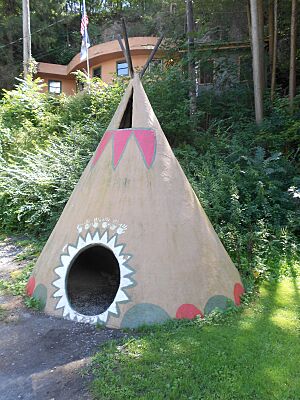Indian Caverns facts for kids
Indian Caverns was a cool show cave in Spruce Creek, Pennsylvania, United States. It was open to visitors from 1929 until 2017. This amazing cave is made of limestone and is thought to be about 500,000 years old! It's the second-largest cave in Pennsylvania and the biggest one made of limestone.
Indian Caverns has two main parts. One part is called the "Historic Cave," which has lower ceilings and is closer to the surface. The other part is the "Giant's Hall," which has very tall passages, some as high as 60 feet! The deepest part of the cave is about 140 feet underground. Inside the cave, the temperature stays the same all year round, a constant 56 degrees Fahrenheit (13 degrees Celsius).
Contents
Indian Caverns: An Amazing Underground World
What is Indian Caverns?
Indian Caverns is a type of cave called a karst cave. This means it formed in limestone rock that slowly dissolved over a very long time. The cave is estimated to be around 500,000 years old, which is super ancient! It's the second-largest cave in Pennsylvania and the biggest one made from limestone.
The cave has two main sections. The "Historic Cave" is closer to the surface, sometimes as shallow as 15 feet deep. It has many interesting rock formations called speleothems. These are like natural decorations made by water dripping over thousands of years.
The "Giant's Hall" section is much larger, with passages that can be up to 60 feet high! While it has fewer small speleothems, it boasts the biggest sheet of flowstone in the northeastern United States. Flowstone looks like a frozen waterfall made of rock. It also has a big rimstone pool, which is a natural pool formed by mineral deposits.
A Home for Ancient People
Scientists have found clues inside Indian Caverns that show people lived there a very long time ago, possibly as far back as 8000 BC! This means the cave was used by humans for thousands of years.
Some of the earliest known groups to use the cave were the Susquehannocks, around the year 1600 AD. Later, other Native American tribes like the Algonkian (including the Lenni Lenape) and Iroquois (like the Mohawk) also used the cave. They continued to use it through the early 1700s.
Many interesting items have been found in the cave, showing how these ancient people lived. You can see some of these artifacts on display inside the cave. They include things like arrowheads, spearheads, tobacco pipes, tomahawks, and even a bone flute! There's also a rare carving of Mesingw, an important guardian spirit for the Algonkian people.
Special Features Inside the Cave
Indian Caverns has some truly unique and magical spots. One room is called the "Grotto of the Wah-Wah-Taysee." In this grotto, parts of the ceiling and walls glow in the dark! This glowing effect is called phosphorescence.
For a long time, people thought this glow came from a special element called radium. But scientists later discovered it's actually caused by a mineral called zinc sulfide reacting with the calcite in the limestone. It's like a natural light show!
Another cool feature in the cave is a "musical rock." When you gently tap this rock, it makes a sound like a bell. It's a natural instrument hidden deep underground!
From Hideout to Tourist Spot
European settlers learned about Indian Caverns in the late 1700s. For a few years, around 1816, the cave was used as a hideout by an outlaw named David Lewis.
In 1928, a local businessman named Harold Wertz, Sr., bought the land where the cave entrance is. He spent two years and a lot of money getting the cave ready for visitors. On June 14, 1929, Indian Caverns officially opened to the public!
At first, Mr. Wertz thought about calling it "Franklin Cave." But after finding many Native American artifacts inside, he decided "Historic Indian Cave" was a better name. Later, in the late 1930s or early 1940s, the name was changed to "Indian Caverns." It became a very popular place for tourists, especially when cars became more common. People loved to explore the "wonders" of nature, and the cave was open continuously for many years.
The Future of Indian Caverns
Indian Caverns remained open until 2017. That year, a group called the Western Pennsylvania Conservancy bought the property. Their goal is to return the cave to its natural state, making it wild again.
The Conservancy has exciting plans for the caverns. They want to turn it into a safe place for bats to live, a special bat sanctuary. They also plan to study the different types of bats that live in the area. This will help protect these important creatures and teach us more about them.


